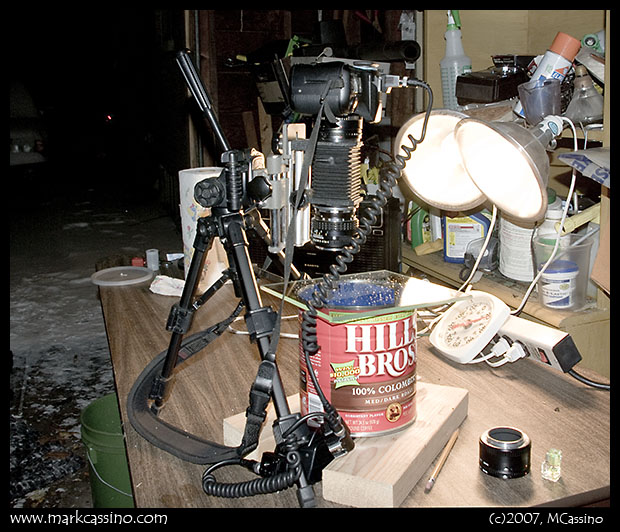5 comments
Comment from: mcc Member
Thanks, Jostein - I’m looking forward to seeing some of your shots this winter!
- MCC
Comment from: Richard D Bush Visitor
Dear Mark,
When I ran across your web page about shooting snowflakes I got very excited. For years I’ve been going to take pictures of them but really didn’t know where to start. I bought The Little Book of Snowflakes by Kenneth Libbrecht. He uses a fancy photo-microscope, so no help there technically. The photographic collection in his book is broad in scope and includes many types that grow differently because of differing atmospheric conditions. The photos, are quite good, but certainly no better or even quite as nice as what you showed in your article.
Maybe you can make suggestions on gear. I have a new Pentax K10D body. I do not yet have an automatic TTL flash, but am considering an after-market unit that would set me back about forty bucks. I know I will additionally need a sync chord that will connect to the K10D hot shoe.
I’ve seen the little leveling do-daws that slide in the hot shoe clip and might get one of those. I do have a small torpedo level and might be able to get plate glass and focal plane plano-parallel by reading the bubble of the torpedo level off the LCD window. (Am I correct in assuming the LCD window is on the same plane as the sensor in the camera?)
I have an Asahi Pentax 50mm ƒ4 preset macro lens that will focus down to a 1:1 size on a 35mm film camera. I don’t know if this lens will still focus 1:1 when it functions as a 50mm x 1.5 and becomes equivelant focal length of a 70mm lens on a 35mm film camera. I have a set of close-up tubes and also an M42-to-K mount adapter to connect any of my old M42 lens collection to the K10D body. With these close up items, can I forget the bellows, or will I still need bellows as a way to connect the rack to the camera and lens configuration?
Any suggestions will be greatly appreciated.
Yours truly,
Richard Bush
Comment from: mcc Member
Hi Richard -
The only drawback with the K10D is that it only supports the digital TTL flash. The *ist-D still supported both the older analog TTL flash and the newer digital. The problem is that the newer TTL flash requires a lens with contacts on the body in order to work properly. If you use your older lens and bellows set, you won’t get TTL flash. The flash will just discharge 100%.
That’s not an insurmountable problem, though. First off, if your flash unit allows you to manually adjust the power, it won’t be too hard to just set it to the proper power level and proceed. Just set up your rig, take some test shots, check the histogram, and adjust the power till the image is properly exposed. That could get to be a bit fiddly if you are moving the lights around much, but it would work.
The other option would be to just use a newer lens, not reverse mounted. You could just get a 100mm maro lens that works in auto mode (i.e. - an “A” or later lens type), some extension tubes with contacts, and reverse mount your 50mm macro onto the front of the main lens. That would quickly get you to 4x lifesized or greater magnification.
So - with the K10D you have two routes. One is to use the bellows setup like I am using, and deal with manual flash. That should not be a big problem.
Second would be to get some extension tubes with contacts, a lens that will allow for the TTL auto-flash to work, a reversing ring to allow you to mount the 50mm lens in front of the main lens. So you’d have your 50mm lens reverse mounted on a 100mm macro, that lens would be mounted on tubes, the tubes onto the camera. Then the TTL flash would work fine and you not have to fuss much with exposures.
Let me know if that makes sense! It can be difficult to explain this stuff without getting too technical.
BTW - the great advantage of using the flash is that it counteracts camera shake, so you can get away with just using a desktop tripod for support. I’ve been tempted to try just using LED lighting, but that would mean stepping up to a much better support system.
I hope this helps!
- MCC
PS: The levels are useful for getting things set up, but ultimately you have to fine tune things by eye. I would think just laying a level on the LCD would work just fine.
Comment from: Susan Egan Visitor
Hi Mark, it just snowed here today and I am looking forward to my third season of photographing snowflakes. I have
had no formal photography training and have managed to
capture these wonderful ice crystals using a Canon Rebel
digital camera body, a bellows for a Minolata manual
SLR and camera stand of sorts. I have been experiment
ing with light sources with limited success. I read your your article and saw the picture of your set up and
now am confident that by copying your coffee can and
flash set up, my pictures will improve dramatically. I
do have a question about the blue plastic film. Could
you please describe for me where it is placed in the
can? Thank you, Susan

Hi Mark,
Thanks for sharing this. I have been wondering about your flash setup. Neat and simple…. Mind if I borrow your idea? :-)
We haven’t had any serious snow here yet, the main bulk usually comes in January and February. But it might come any day, of course. I’ll take your post as a reminder to get started.
best,
Jostein